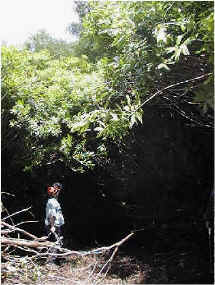
Woodland Restoration Project
SUMMARY

Clearance of rhododendron. Note the height and density.
| 1. The Woodland Project is part of an on-going program of restoration of the Woodland Education Centre. It will clear a significant area of rhododendron from woodland in a north-eastern section of the Centre. Rhododendron leaf litter will also be cleared from the project site and burned. 2. The aim of the project is to increase biodiversity in the area through the removal of the rhododendron. Natural regeneration will be encouraged through proactive management, which will include some replanting of native species. The regeneration of rhododendron on the site will be prevented. 3. Three surveys will be carried out during the course of the project. This, the first, will document vegetation present on the site prior to clearance. The second will be carried out once clearance is complete, and the third, a year later. 4. Vegetation on the site prior to clearance consisted almost exclusively of rhododendron and silver birch, oak, rowan and holly trees which had grown above the level of the rhododendron before it completely dominated the area. These trees were generally tall and poorly developed as a result of the constant competition with the rhododendron. The woodland floor beneath the rhododendron canopy was essentially bare of vegetation as a result of low light levels. 5. The vegetation appeared to be superficially homogeneous, but closer inspection revealed quite marked differences across the project site. Four different regions were identified. Each of these was sampled separately. A 20m square quadrat was set up in each region and the vegetation inside each square was sampled. One of these regions was an area already cleared of rhododendron two years previously in a pilot project. This region had thus already had two years to regenerate after removal of the rhododendron. 6. A total of 24 species were recorded on the site. Of these, only 12 occurred in the areas covered by rhododendron. Twenty two species were found in the area cleared during the pilot project. Nine of these were species which must have colonized the area after removal of the rhododendron. Two years of regeneration has therefore resulted in a 75% increase in species diversity. 7. The species colonizing the cleared area were mainly mosses. Other new species found in this area included brambles, foxgloves, ivy, a sedge and bedstraw. Holly seedlings were also present in quite high densities. The main factor involved in this increase in species diversity is likely to be the increase in light levels with the removal of the rhododendron. (As little as 5% of full daylight penetrates dense rhododendron canopy. Light conditions under the canopy on a dull day can require the use of a torch for adequate visibility.) 8. Although several new species were present in the cleared area, plants were very few and far between and the woodland floor was still very bare of vegetation. This indicates that complete regeneration is likely to take a long time. Regenerating rhododendron stumps and new seedlings illustrate the need for continued control of the rhododendron, even after clearance. 9. The rhododendron showed different growth forms across the project site. In one area where the soil was very shallow and covered in flints, it grew in an upright tree-like form. In other areas, the stems tended to grow horizontally, intertwining into a very dense tangled web. The difference in growth forms is likely to be due to the fact that in the region with very poor soil, the rhododendron was competing with silver birch trees which were present in a density twice that anywhere else on the project site. 10. The identification of regional differences in the vegetation cover across the site prior to clearance, should aid in understanding future observed patterns of regeneration in the area. |
